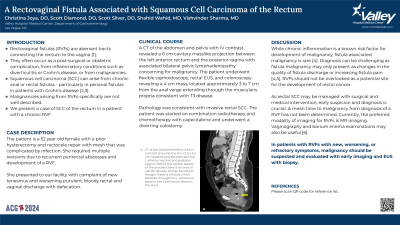Tuesday Poster Session
Category: Colorectal Cancer Prevention
P3874 - A Rectovaginal Fistula Associated With Squamous Cell Carcinoma of the Rectum
Tuesday, October 29, 2024
10:30 AM - 4:00 PM ET
Location: Exhibit Hall E

Has Audio

Christina Joya, DO
Valley Hospital Medical Center
Las Vegas, NV
Presenting Author(s)
Christina Joya, DO, Scott Diamond, DO, Shahid Wahid, MD, Vishvinder Sharma, MD
Valley Hospital Medical Center, Las Vegas, NV
Introduction: Rectovaginal fistulas (RVFs), aberrant tracts connecting the rectum to the vagina, often occur as a post-surgical or obstetric complication, from inflammatory conditions such as diverticulitis or Crohn’s disease, or from malignancies. Squamous cell carcinoma (SCC) can arise from chronic anal or rectal fistulas - particularly in perianal fistulas in patients with Crohn’s disease. Malignancies arising from RVFs specifically are not well described. We present a case of SCC of the rectum in a patient with a chronic RVF.
Case Description/Methods: The patient is a 52 year old female with a prior hysterectomy and rectocele repair with mesh which was complicated by infection. She required multiple mesh revisions due to recurrent perirectal abscesses and she developed a RVF. She presented with new tenesmus and worsening purulent, bloody rectal and vaginal discharge with defecation. A CT of the abdomen and pelvis with IV contrast revealed a 6 cm cavitary masslike projection between the left anterior rectum and the posterior vagina with associated bilateral pelvic lymphadenopathy. Concern for malignancy prompted a flexible sigmoidoscopy with rectal EUS revealing a 4 cm mass located 3-7 cm from the anal verge extending through the muscularis propria -- T3 disease. Pathology was consistent with invasive rectal SCC. She was started on combination radiation and chemotherapy with capecitabine and underwent a diverting colostomy.
Discussion: Chronic inflammation is a risk factor for the development of malignancy, however, fistula associated malignancy is uncommon. Diagnosis can be challenging as presenting symptoms are subtle and may only be changes in discharge quality or an increase in pain. RVFs should not be overlooked as a potential site for the development of cancer. Early suspicion and diagnosis is crucial, a mean time to malignancy from diagnosis of a RVF has not been determined. The preferred modality of imaging for RVFs is MR imaging. Vaginography and barium enema examinations may also be useful. In patients with RVFs with new, worsening, or refractory symptoms, malignancy should be suspected and evaluated with early imaging and EUS with biopsy. Further research is needed to establish screening guidelines in select patient populations.
Disclosures:
Christina Joya, DO, Scott Diamond, DO, Shahid Wahid, MD, Vishvinder Sharma, MD. P3874 - A Rectovaginal Fistula Associated With Squamous Cell Carcinoma of the Rectum, ACG 2024 Annual Scientific Meeting Abstracts. Philadelphia, PA: American College of Gastroenterology.
Valley Hospital Medical Center, Las Vegas, NV
Introduction: Rectovaginal fistulas (RVFs), aberrant tracts connecting the rectum to the vagina, often occur as a post-surgical or obstetric complication, from inflammatory conditions such as diverticulitis or Crohn’s disease, or from malignancies. Squamous cell carcinoma (SCC) can arise from chronic anal or rectal fistulas - particularly in perianal fistulas in patients with Crohn’s disease. Malignancies arising from RVFs specifically are not well described. We present a case of SCC of the rectum in a patient with a chronic RVF.
Case Description/Methods: The patient is a 52 year old female with a prior hysterectomy and rectocele repair with mesh which was complicated by infection. She required multiple mesh revisions due to recurrent perirectal abscesses and she developed a RVF. She presented with new tenesmus and worsening purulent, bloody rectal and vaginal discharge with defecation. A CT of the abdomen and pelvis with IV contrast revealed a 6 cm cavitary masslike projection between the left anterior rectum and the posterior vagina with associated bilateral pelvic lymphadenopathy. Concern for malignancy prompted a flexible sigmoidoscopy with rectal EUS revealing a 4 cm mass located 3-7 cm from the anal verge extending through the muscularis propria -- T3 disease. Pathology was consistent with invasive rectal SCC. She was started on combination radiation and chemotherapy with capecitabine and underwent a diverting colostomy.
Discussion: Chronic inflammation is a risk factor for the development of malignancy, however, fistula associated malignancy is uncommon. Diagnosis can be challenging as presenting symptoms are subtle and may only be changes in discharge quality or an increase in pain. RVFs should not be overlooked as a potential site for the development of cancer. Early suspicion and diagnosis is crucial, a mean time to malignancy from diagnosis of a RVF has not been determined. The preferred modality of imaging for RVFs is MR imaging. Vaginography and barium enema examinations may also be useful. In patients with RVFs with new, worsening, or refractory symptoms, malignancy should be suspected and evaluated with early imaging and EUS with biopsy. Further research is needed to establish screening guidelines in select patient populations.
Disclosures:
Christina Joya indicated no relevant financial relationships.
Scott Diamond indicated no relevant financial relationships.
Shahid Wahid indicated no relevant financial relationships.
Vishvinder Sharma indicated no relevant financial relationships.
Christina Joya, DO, Scott Diamond, DO, Shahid Wahid, MD, Vishvinder Sharma, MD. P3874 - A Rectovaginal Fistula Associated With Squamous Cell Carcinoma of the Rectum, ACG 2024 Annual Scientific Meeting Abstracts. Philadelphia, PA: American College of Gastroenterology.
